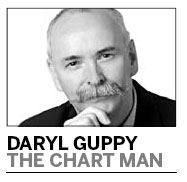Daryl Guppy
Getting an edge by combining analysis methods
By Daryl Guppy (China Daily)
Updated: 2011-06-20 16:56
 |
Large Medium Small |
 A few days ago I spoke at a conference with economist Dr Nouriel Roubini, who is widely credited with predicting the global financial crisis and the 2008 market collapse. He outlined three possible global economic scenarios.
A few days ago I spoke at a conference with economist Dr Nouriel Roubini, who is widely credited with predicting the global financial crisis and the 2008 market collapse. He outlined three possible global economic scenarios.
He believed there was a one-in-three chance that the fiscal woes in the United States, the debt restructuring in Europe, stagnation in the Japanese economy and a slowdown in China growth would combine to stunt global economic growth from 2013.
If growth did not stall then he said there would be either anemic growth or a faster recovery. He hinted that a falling Dow Jones Industrial Average Index would increase the probability of a third round of quantitative easing in the US.
How do investors put this analysis into action? The first step is to recognize several important broad patterns of market behavior that appear on market index charts. These are used to verify information received from other sources and analysis, such as from Roubini. There are two significant patterns for market indexes.
The first is a head-and-shoulders pattern. This is created by a rally and retreat. This is followed by a higher rally and another retreat. This forms the left shoulder and the head of the pattern. The pattern is confirmed with another rally that reaches a lower peak than the previous rally. The retreat confirms the development of the right shoulder in the pattern. The two retreat lows in the completed pattern are joined by a trend line, or neckline. The distance between the head and the neckline is measured and this value projected downward to give a downside target.
The Dow index is currently showing a small head-and-shoulders pattern with a downside target near 11600. This indicates a trend correction rather than a market collapse. In 2007 the Dow developed a large head-and-shoulders pattern that gave extreme downside targets. This indicated a market collapse. Investors who knew how to recognize these patterns were able to take defensive action before the market collapse developed in 2008.
| ||||
The second significant pattern is the rounding top. This is created by a series of higher rally highs followed by a series of lower rally highs. The upper edges of this price behavior are best described with a curved trend line. The rounding top pattern was seen in the FTSE 100-Share Index in 2007. The base of the pattern is located at support levels. The depth of the pattern is measured, and this value is projected down to set downside targets.
The FTSE achieved the rounding top target projections in October 2008.
These are long-term patterns developing over weeks and months so they give ample warning of a change in market conditions. These patterns also appear in commodity markets with a rounding top pattern currently appearing in London Metal Exchange copper. Commodity markets are home to a unique pattern that also indicates the end of a trend.
Commodity markets often develop a parabolic trend pattern. This is a fast moving rising trend. The behavior is best described with a parabolic trend line but in this case the trend line becomes vertical. This gives an ending date for the upward trend. The end of the trend is usually very rapid with a large price collapse. The oil price collapse from $140 in 2007 came after a parabolic trend. The collapse of the US Dollar Index in 2010 also came at the end of a parabolic trend.
Combined with these patterns is a technical indicator. This is the Relative Strength Index (RSI). The RSI compares the internal strength of a stock by looking at the average of the upward price changes and comparing it with the average of the downward price changes.
It is particularly useful when the RSI flashes a divergence signal. This develops when the trend line on the index chart moves in the opposite direction to a trend line on the RSI indicator. On the RSI indicator it is only the lows below the 30 percent line or the highs above the 70 percent line that are used in divergence trend line calculations.
Between October 2008 and March 2009 the Dow index had a well-defined downward trend. The downward trend line joined the lows in the Dow during the period. During the same period, the trend line drawn on the lows of the RSI sloped upward. This was an RSI divergence signal. This signal confirmed the 2009 Dow upward trend breakout.
Price chart analysis captures the combined feelings of all market participants. The patterns of behavior reflect human behavior and some patterns give advance warning of trend changes. A combination of analysis methods gives investors a significant edge.
The author is a well-known international financial technical analysis expert.
| 分享按钮 |



